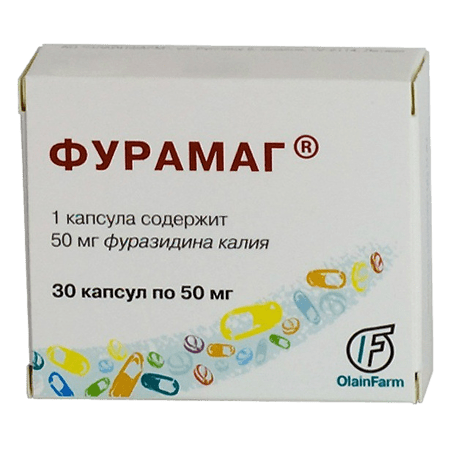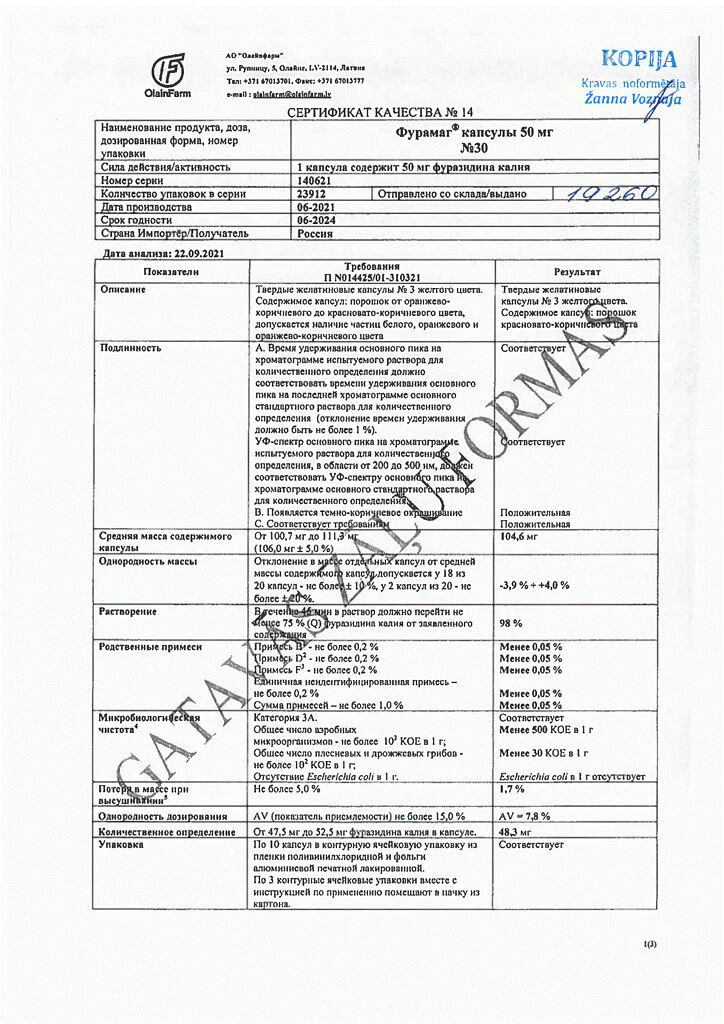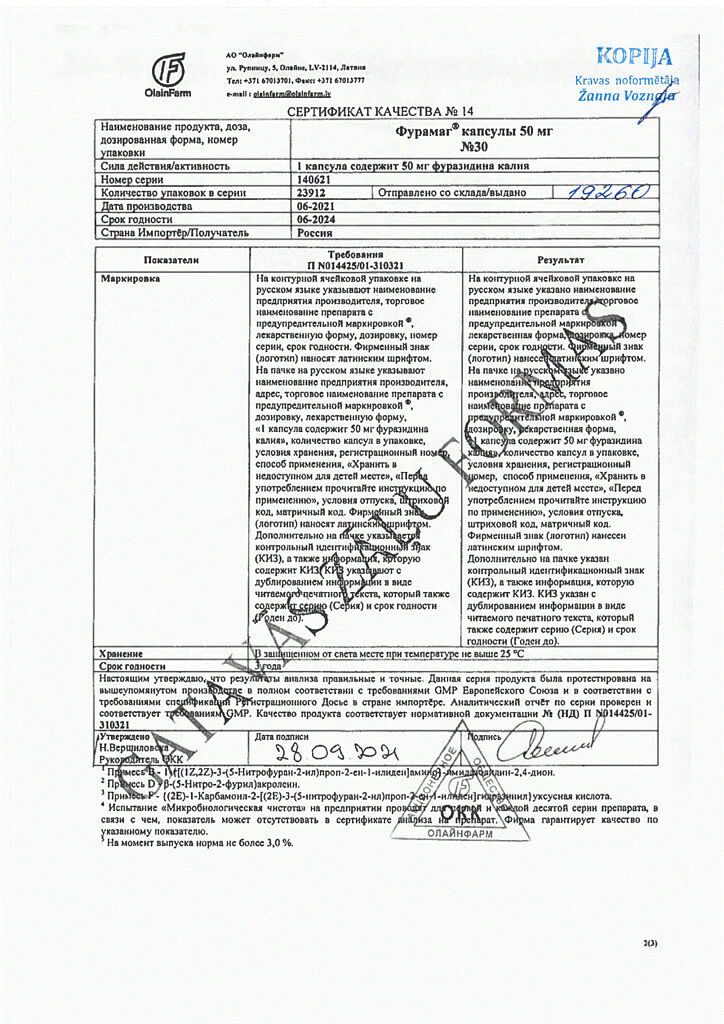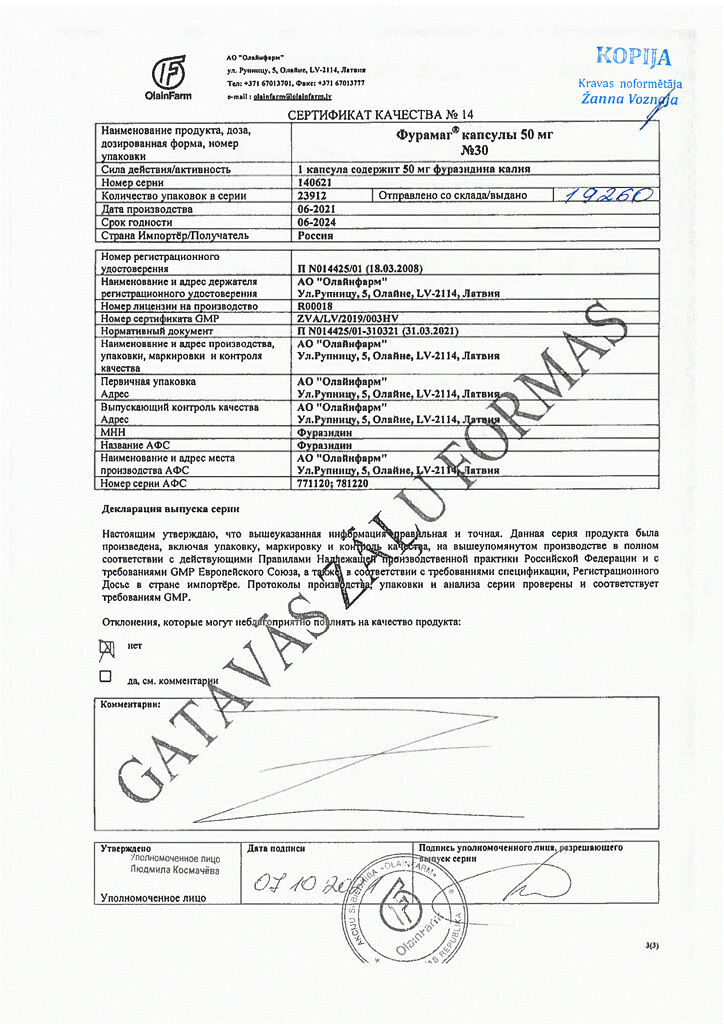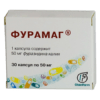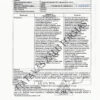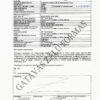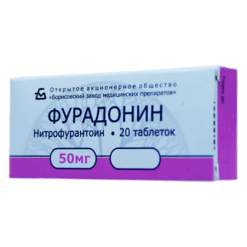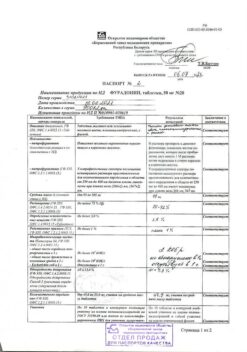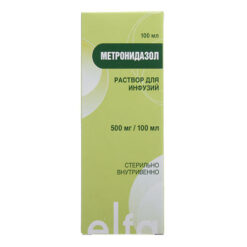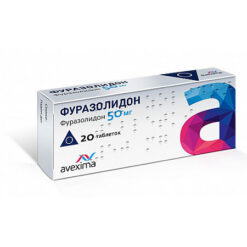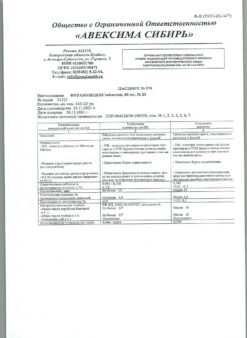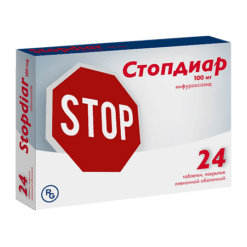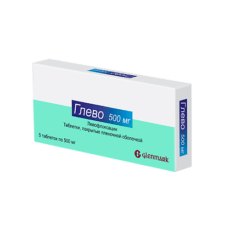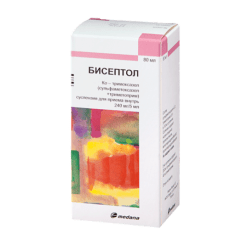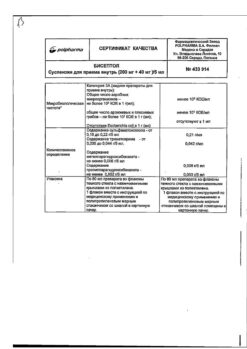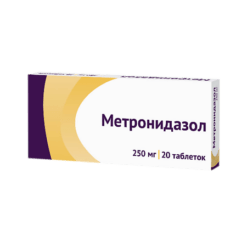No products in the cart.
Furamag, 50 mg capsules 30 pcs
€26.49 €22.08
Description
Pharmacodynamics
Furamag is a broad-spectrum antimicrobial agent belonging to the group of nitrofurans.
Resistance to Furamag develops slowly and does not reach a high degree.
It is active against Gram-positive and Gram-negative microbes, pathogenic strains of Staphylococcus spp. and other microorganisms resistant to antibiotics.
It is effective against Gram-positive cocci (strepto-, staphylococci), Gram-negative bacilli (Escherichia coli, Salmonella, Shigella, Protea, Klebsiella, Enterobacteriaceae), protozoa (giardia). Furamag® is more active against Staphylococcus spp., E.coli, Aerobacter aerogenes, Bact. citrovorum, Proteus mirabilis, Proteus morganii compared to other nitrofurans. Furamag® shows higher activity against Enterococcus faecalis, Staphylococcus spp. no compared to other groups of antimicrobials.
Against most bacteria, the bacteriostatic concentration is 1:100,000 to 1:200,000; the bactericidal concentration is about 2 times higher. Under the influence of nitrofurans in microorganisms, the respiratory chain and the tricarboxylic acid cycle (Krebs cycle) are inhibited, and other biochemical processes in microorganisms are inhibited, resulting in destruction of their shell or cytoplasmic membrane. As a result of the action of nitrofurans, microorganisms release fewer toxins, so improvement in the general condition of the patient is possible even before a pronounced suppression of microflora growth. Nitrofurans, unlike many other antimicrobial agents, not only do not suppress the body’s immune system, but rather activate it (increase complement titer and ability of leukocytes to phagocytize microorganisms). Nitrofurans in therapeutic doses stimulate leukopoiesis.
Pharmacokinetics
Absorption occurs in the small intestine, by passive diffusion. Absorption of nitrofurans from the distal segment of the small intestine is 2 and 4 times higher than absorption from the proximal and middle segments, respectively (should be considered in simultaneous treatment of urogenital infections and GI diseases, including chronic enteritis). Nitrofurans are poorly absorbed in the colon.
Furamag being a mixture of potassium furazidine and magnesium hydroxycarbonate in 1:1 ratio has higher bioavailability than furazidine when taken orally (after taking Furamag capsule in acidic environment of the stomach the potassium furazidine does not convert into poorly soluble furazidine). In the body the drug is distributed evenly. Clinically important is high content of the active substance in lymph (delays the spread of infection along the lymphatic tract). In bile, its concentration is several times higher than in blood serum, and in liquor, several times lower than in serum. In saliva, the furazidine content is 30% of its concentration in serum. The concentration of furazidine in blood and tissues is relatively low, which is due to its rapid excretion, while the concentration in urine is significantly higher than in blood. Cmax in blood lasts from 3 to 7 or 8 hours, in the urine furazidine is detected 3-4 hours after use.
In contrast to nitrofurantoin (furadonin), the pH of the urine does not change after taking Furamag. In 4 hours after taking the drug the concentration of furazidine in urine is much higher than the concentration that is formed after taking the same dose of Furagin. Excretion through the kidneys occurs during glomerular filtration and tubular secretion (85%), partially subjected to reverse reabsorption in the tubules. At low concentrations of the drug in the urine the filtration and secretion process prevails, at high – the secretion decreases and reabsorption increases. Furazidine, being a weak acid, does not dissociate in acidic urine and undergoes intensive reabsorption, which may increase the development of systemic side effects. Furazidine excretion is increased when urine is alkaline.
It is slightly biotransformed (less than 10%). When renal excretory function decreases, the intensity of metabolism increases.
Indications
Indications
Infections caused by microorganisms sensitive to furazidin: urogenital infections (acute cystitis, urethritis, pyelonephritis), skin and soft tissue infections, severe infected burns, gynecological infections. Can be used prophylactically during urological operations, cystoscopy, catheterization, etc.
Pharmacological effect
Pharmacological effect
A broad-spectrum antimicrobial agent belonging to the nitrofuran group. Resistance to Furamag develops slowly and does not reach a high degree.
Effective against gram-positive cocci (Staphylococcus spp., Streptococcus spp.), gram-negative bacilli (E. coli, Salmonella spp., Shigella spp., Klebsiella spp., Enterobacter). Plasmodium aeruginosa, Enterococcus spp., Acinetobacter spp., most strains of Proteus spp., Serratia spp. are resistant. The mechanism of action is associated with inhibition of nucleic acid synthesis. Depending on the concentration, it has a bactericidal or bacteriostatic effect. In relation to Staphylococcus spp., E.coli, Aerobacter aerogenes, Bact. Citrovorum, Proteus mirabilis, Proteus morganii Furamag, compared to other nitrofurans, is more active. Furamag exhibits higher activity against Enterococcus faecalis, Staphylococcus spp. compared to other groups of antimicrobial drugs.
Against most bacteria, the bacteriostatic concentration ranges from 1:100,000 to 1:200,000. The bactericidal concentration is approximately twice as high. Under the influence of nitrofurans in microorganisms, the respiratory chain and the tricarboxylic acid cycle (Krebs cycle) are suppressed, as well as other biochemical processes of microorganisms are suppressed, resulting in the destruction of their shell or cytoplasmic membrane. As a result of the action of nitrofurans, microorganisms produce fewer toxins, and therefore an improvement in the general condition of the patient is possible even before a pronounced suppression of the growth of microflora.
Active ingredient
Active ingredient
Furazidin
Composition
Composition
Composition of the contents of one capsule:
Active ingredient:
Furazidine 43.70 mg, which corresponds to potassium furazidine 50.00 mg;
Excipients:
magnesium hydroxycarbonate 50.00 mg,
talc 3.00 mg,
corn starch 2.50 mg,
sodium stearyl fumarate 0.50 mg,
Hard gelatin capsules No. 3:
titanium dioxide (E 171) 1.32%
quinoline yellow dye (E 104) 1.2%,
gelatin 97.48%.
Contraindications
Contraindications
-Hypersensitivity to furazidine, drugs of the nitrofuran group, other excipients
-severe chronic renal failure (glomerular filtration rate less than 30 ml/min)
-pregnancy
-breastfeeding period
-polyneuropathy (including diabetic)
-porphyria
-children under 18 years of age
With caution:
-Glucose-6-phosphate dehydrogenase deficiency
-impaired kidney function of mild to moderate severity, liver
-anemia
– deficiency of B vitamins and folic acid
-lung diseases (especially in patients over 65 years of age)
-diabetes mellitus
Side Effects
Side Effects
Blood and lymphatic system disorders
agranulocytosis, thrombocytopenia, aplastic anemia
Immune system disorders
pruritus, papular rash, angioedema, urticaria, exfoliative dermatitis, erythema multiforme
Nervous system disorders
dizziness, headache, drowsiness, peripheral neuropathy
Visual disorders
visual impairment
Vascular disorders
intracranial hypertension
Disorders of the respiratory system, chest and mediastinal organs
acute or chronic reaction from the lungs. An acute reaction from the lungs develops quickly and manifests itself in the form of acute shortness of breath, fever, chest pain, cough with or without sputum, eosinophilia (reversible after discontinuation of the drug). Skin rash, itching, urticaria, angioedema and myalgia have also been reported. Chronic pulmonary reaction may occur over a long period of time after stopping treatment and is characterized by a gradual increase in dyspnea, increased respiratory rate, intermittent fever, eosinophilia, progressive cough, and interstitial pneumonitis and/or pulmonary fibrosis.
Gastrointestinal disorders
nausea, vomiting, loss of appetite, diarrhea, pancreatitis
Disorders of the liver and biliary tract
cholestatic jaundice, hepatitis
Musculoskeletal and connective tissue disorders
arthralgia
General disorders and disorders at the injection site
fever, weakness, reversible alopecia, dark yellow or brown urine
Interaction
Interaction
Furamag should not be used together with ristomycin, chloramphenicol, sulfonamides (the risk of hematopoietic suppression increases).
During the treatment period, it is advisable to refrain from drinking alcoholic beverages, because side effects may increase.
It is not recommended to prescribe drugs that can “acidify” urine (including ascorbic acid, calcium chloride) simultaneously with nitrofurans.
Overdose
Overdose
In case of overdose, symptoms of a neurotoxic nature, ataxia and tremor are observed.
In case of poisoning, drink plenty of liquid. Antihistamines are used to relieve acute symptoms. To prevent neuritis, it is possible to prescribe vitamins (thiamine bromide).
Storage conditions
Storage conditions
In a dry place, protected from light, at a temperature not exceeding 25 ° C.
Keep out of the reach of children.
Shelf life
Shelf life
3 years
Manufacturer
Manufacturer
Olainfarm, Latvia
Additional information
| Shelf life | 3 years |
|---|---|
| Conditions of storage | In a dry, light-protected place at a temperature not exceeding 25 °C |
| Manufacturer | Olinefarm, Latvia |
| Medication form | capsules |
| Brand | Olinefarm |
Related products
Buy Furamag, 50 mg capsules 30 pcs with delivery to USA, UK, Europe and over 120 other countries.

